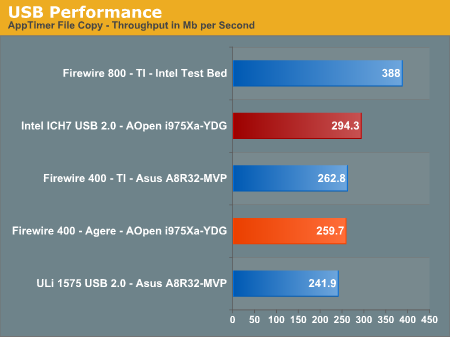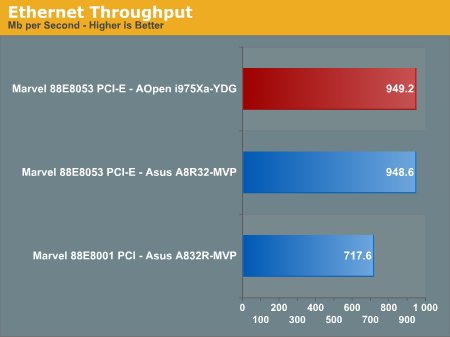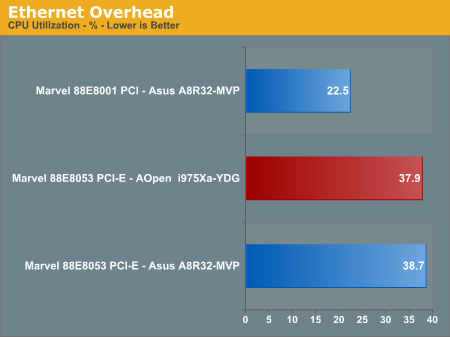Intel Core Duo: AOpen i975Xa-YDG to the Rescue
by Gary Key on May 4, 2006 8:00 AM EST- Posted in
- Motherboards
Firewire and USB Performance
After looking at many options for Firewire and USB testing, we finally determined that an external USB 2.0, Firewire 400, and Firewire 800 hard disk would be a sensible way to look at USB and Firewire throughput. We utilize a RAM disk as our "server", since memory removes almost all overhead from the serving end. We turn off disk caching on the USB and Firewire side by setting up the drives for "quick disconnect" so our results are consistent.We use 2GB of fast 3-3-3-8 system memory set up as a 450MB RAM disk and 1550MB of system memory. Our standard file is the SPECviewPerf install file, which measures 432,533,504 bytes (412.4961MB). After copying this file to our RAM disk, we measured the time for writing from the RAM disk to our external USB 2.0, Firewire 400, or Firewire 800 drive utilizing our internal Windows based timing program. The copy times in seconds were then converted into Megabits per second (Mb) to provide a convenient means of comparing throughput. Higher Rates therefore mean better performance in this particular test.

Possibly the most interesting finding in our Firewire and USB throughput tests is the outstanding performance of an external hard drive connected to Firewire 800. Our benchmarks show Firewire 800 is up to 48% faster than a drive connected to the more common Firewire 400, and about 32% faster than the fastest USB 2.0 solution.
The AOpen board offers the Agere based IEEE 1394 Firewire option that provides very competitive performance with the more common TI chipset solutions. The Intel USB 2.0 performance offers 22% better performance than the ULi based controller in throughput.
Ethernet Performance
The current motherboard test suite includes LAN performance measurements. All of these boards utilize PCI or PCI Express based controllers with the only difference being the supplier of the core logic.The Windows 2000 Driver Development Kit (DDK) includes a useful LAN testing utility called NTttcp. We used the NTttcp tool to test Ethernet throughput and the CPU utilization of the various Ethernet Controllers used on the Intel motherboards.
We set up one machine as the server; in this test, an Intel system with an Intel CSA Gigabit LAN connection. Intel CSA has a reputation for providing fast throughput and is a logical choice for our Gigabit LAN server.
On the server side, we used the following Command Line as suggested by the VIA whitepaper on LAN testing:
Ntttcpr -m 4,0,‹server IP› -a 4 -l 256000 -n 30000
Ntttcps -m 4,0,‹client IP› -a 4 -l 256000 -n 30000


AOpen's choice of the Marvell 88E8053 10/100/1000Mb/s Ethernet controller is an excellent addition to this board. The performance is basically equal to that of the same Marvell 88E8053 controller utilized on the Asus board. The lower CPU utilization rate on the Marvel 88E8001 PCI controller is directly attributable to the lower throughput numbers generated in our tests.










81 Comments
View All Comments
BrownTown - Thursday, May 4, 2006 - link
Conroe prices have been out for like 4 months now, they are anything but overpriced, actually way underpriced when it comes to performance/$$$.